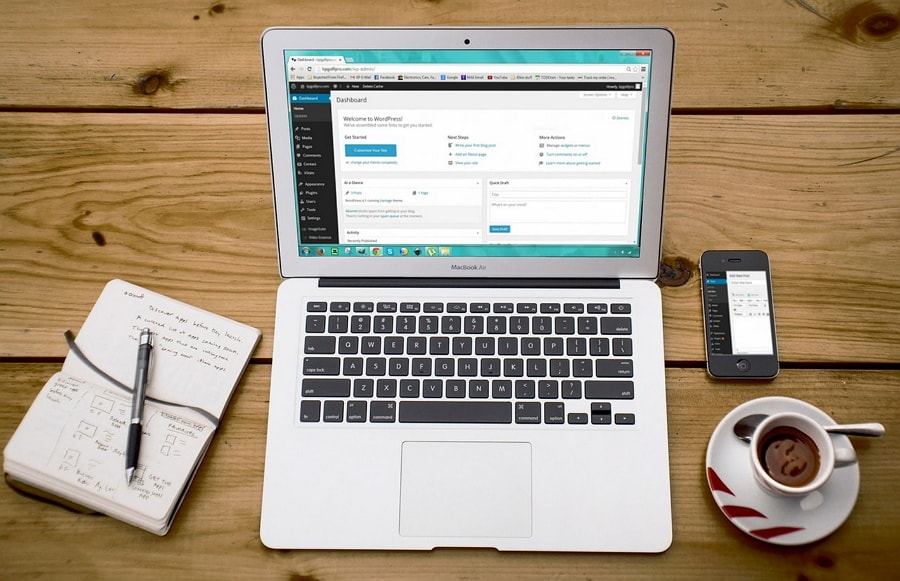What You Must Know Before Getting Your Website Designed In Singapore!
Here are some of the most common problems I hear from business owners:
1. Their web designer has become unresponsive, or worse still, their web designer “disappeared” or became uncontactable
2. Updating their website became too costly and took too long (some business owners get charged $200 per update and they have to wait up to 7 working days for their website to get updated)
3. A friend of theirs helped them to set up their website in the beginning, but now their friend is busy and is unable to help them to maintain their website on an ongoing basis (in some cases, the business owners prefer not to trouble their friend who has been kind enough to help them out of goodwill.)
4. Their website got hacked and they don’t know who can help them
5. Their domain name expired before they realized it and they don’t know what they should do
The above are some examples and the list just goes on…

Fortunately for you if you are reading this post, most of these problems can be avoided if you are equipped with some basic knowledge in managing your website (or project expectations if you are getting someone to design a website for you).
In the rest of this post, I will share with you 6 important tips that you must know that will allow you to manage your own website (if you choose to) when issues arise.
Or if you are hiring a web designer, you will know what to look out for before you commence your website project that will save you from headaches (like those mentioned above) down the road!
For clarity sake, in this whole post, when you see the words “web designer”, it can refer to web designers, web development companies or even your friends who designed your website for you.
Let’s dive in!
1) Use A Content Management System To Create Your Website
My first suggestion for you is that you need to be clear about what software is used to create your website.
If you are planning to hire a web designer, do check with him/her what software he/she will be using to create your website.
This may not seem like the most important consideration in the beginning, but you will be thankful you did, especially when the time comes for you to learn how to update your website yourself.
In the past, the only way to create a website is by learning programming languages like HTML and CSS. But things are vastly different now.
Today, a website can be created from scratch using CMS (Content Management System) – and this is what I encourage you to use to create your website.

In case you’re wondering what CMS means, it is a software that allows you to create a fully-functioning website without the need to know any HTML or coding.
To clarify, having knowledge in HTML and CSS is still a plus especially if you require extra customization for your website. But in most cases, programming knowledge is not required for creating a basic website.
With the invention of CMS, creating and updating a website has now become so much easier.
It is possible for anyone to learn to login to their CMS website dashboard, make some simple edits and save the web page, much like the way you use conventional text editors like Microsoft word.
A popular CMS that I recommend is WordPress, which is more user-friendly as compared to other CMS like Joomla and Drupal.
You may have also heard of Magento, which is a software created primarily for eCommerce sites. Unless the main function of your website is to sell products or services online, I wouldn’t recommend Magento as it is not as easy to use as compared to WordPress.
Before we move on, I just want to highlight this again.
As a business owner, you want to make sure that you have control over your own website as much as possible. And one of the key things is having the ability to make basic changes to your website, especially during times when you have no one else to rely on but yourself!
So never let your web designer create your website in pure HTML, because that will mean that you will not have the empowerment to update the website yourself in future (unless you have knowledge in HTML or CSS).
If you haven’t had the chance to see how WordPress works, this video shows you how simple it is to edit a webpage in WordPress!
2) Take Ownership Of Your Website Credentials
This is so important but it is also one of those fatal traps that many business owners fall into.
I was shocked when I came to know that many of my business friends do not even have the login information to their own domain name and website!
The rule of thumb is, no matter who you get to design your website, you are the owner of the website. Not the web designer, not the web designing company.
That means you must take full ownership of the login credentials for your online assets.
Many business owners overlook this and assume that the information is safe with their web designer. But it’s too late to cry over spilled milk when things go wrong and their web designers go missing.
There is no way you can take back your website.
So if you have a website currently, make sure you have access to the following credentials so that you won’t find yourself stuck in such frustrating circumstances.
And yes, that means even if your web designer is currently helping you to maintain your website, you should also get the following information from him/her and keep it safely with you.

(a) Domain Name Login
To have a website, you must register for a domain name. Do take note that domain names need to be renewed every year (unless you have paid for several years in advance).
You can use this checker tool to check the expiry date of your domain name if you are unsure when it is due for renewal.
Ideally you should register for the domain name yourself. If you are located in Singapore, you can register for a domain name over at Vodien and the login details for your domain will be emailed to you for your safekeeping.
Should you decide to let your web designer register the domain name on your behalf, it is important that you ask him/her for the login username and password so that you still retain the control of your own domain name.
(b) Web Hosting Login
The second set of login credentials you need is for your web hosting account, which provides you with online storage to save all the files and images for your website.
Similar to your domain, web hosting services are also renewable every year (unless you have paid for several years in advance).
I would also encourage you to sign up for your web hosting package yourself (you can register your domain name together with your web hosting at Vodien), then pass on the login information to your web designer if necessary.
If you already have a website but you are not sure who your web hosting provider is, you should clarify with your web designer as well as get your login username and password from him/her.
(c) Expiry Date Of Your Domain Name And Web Hosting
Remember, NEVER ever let your domain name or web hosting expire because that will mean that your website will be deleted – forever.
I do know of some business friends who have had their websites deleted because they failed to renew their web hosting before their subscription lapsed. They thought that their web designer will be prompt in reminding them but they didn’t.
So the onus is on you to take note of the expiry date of your domain name and web hosting package and make sure you remember to renew them on time.
Once they expire, there is no way you can recover your website content after it is deleted permanently.
(d) Website Login
Apart from your domain name and web hosting accounts, one other piece of important information you need to keep is your website login.
If it is a WordPress website, it would be the username and password for logging into your WordPress dashboard (yourdomainname.com/wp-admin).
It is important that you have this login information so that you have the access to add or update content in your website.
3) Know The Rates And Turnaround Time For Ongoing Updates And Maintenance
The next important question you need to ask yourself is: Who will be responsible for updating the website after it is completed – are you going to update it yourself? Or are you looking to outsource it?
If you wish to update the website yourself, be sure to communicate your request for a training session to your web designer so that he/she can make arrangements to teach you how to update your website after it is completed.
Some web designers may charge additional fees for training so it is best to check with them in advance if the session is chargeable.

Let me also manage your expectations upfront.
Although most CMS is designed to be easy to use, it may take some time for you to be familiarized with using the software especially if you are new to it.
There may also be certain parts of the website that you wish to modify but it can only be done with the knowledge of HTML or CSS. So if you choose to update the website yourself, do be prepared to invest additional time to learn from other sources (such as online learning on Udemy, YouTube, etc) should the need arise.
On the other hand, if you do not wish to update the website yourself, you can check with your web designer whether he/she provides ongoing support and maintenance services.
There are usually two components to their web maintenance packages – content updates and website security.
For content updates, you just have to send the list of updates that you want for your website to your web designer and he/she will do it for you in the specified time frame.
Most web designers limit the number of updates that you can request for every month depending on the type of maintenance package that you sign up for, so do select a suitable package for your needs.
If you think that you will have a lot of updates to be done every month, it might be a good idea to ask your web designer for a customized package.
As for website security, it means that the web designer will help you to make sure that your website software is regularly updated. For WordPress sites, the theme, core files and plugins must be regularly updated (preferably weekly) to minimize vulnerabilities to your website.
It is also good practice to backup your website regularly (preferably daily) so that you won’t have to worry about losing all your data in the event that your website is down.
When you backup a WordPress site, you should backup the files, images and SQL tables (database). Make sure your web designer sends you a copy of the backup from time to time for your safekeeping.
Here’s another tip: don’t rely solely on the backup done by your web hosting company because they typically only keep one backup copy of your website at any point in time.
In other words, once today’s backup is done, yesterday’s backup will be deleted from their database.
The problem with this is that most business owners do not check their websites every day. By the time they realize that their website is hacked, it could be days or even weeks later.
So if your site got hacked three days ago, that means the backup done by your web hosting company will also be the hacked version!
This has happened so many times to my own business friends so I don’t want you to repeat the same mistake.

To sum things up, let me share with you an important lesson.
Many business friends I know failed to take ongoing website maintenance expenses into consideration when planning for their web development budget, and hence some of them decided to forego maintenance support.
But in my experience, if you do not have good support for your website, having your website hacked one time is all it takes for your data to be wiped out and you may never be able to restore your site again (or you may need to pay a heavy price tag to get it restored).
So if you want to have a healthy website up and running at all times, make sure you set aside a reasonable budget for web maintenance so that your website is well taken care of.
Never underestimate the importance of ongoing maintenance support for your website because more damages can be done (to your wallet and branding) when your website gets hacked!
4) Rights For Images And Icons Used On Your Website
Now let’s talk about the images used on your website. This is an important area to look into because potential legal issues can arise if it is not properly managed.
In case you are unaware, you can’t simply download images from the web and use them for your own website. That’s because you do not own the rights to these images.
Virtually any image that you see on the web is regulated by some form of copyright or license.
Some will require you to pay a fee in order to use them. Granted, even if an image is free, it does not mean you are allowed to use them especially for commercial applications.
So always make it a habit to read through and understand the license terms thoroughly. If in doubt, you might want to avoid using such images totally.
Quite recently, you may have heard of businesses in Singapore getting lawyer letters from Getty Images’s representatives (yes, physical ones) suing them for unauthorized use of their images.
These problems can get tricky and involve hefty penalties. To protect yourself, make sure you have the rights to every image that you use on your own website so you won’t land yourself in any legal trouble.
If you are getting a web designer to create your website, the responsibility lies with you too. After all, you are the owner of the website.
Many of my business friends do not have any idea where the images on their website come from because they just leave the task to the web designer.
Problem is, some web designers may go to Google and casually download images to upload to your website without you knowing, if you didn’t bother to find out.
So instead of letting your web designer use images from an unknown source, one of the safest ways is to use your own images – whether these are photographs that you took yourself or you got a professional photographer to do it – because you own the rights to these images.
Otherwise, you caould suggest your web designer to purchase professional images from websites like Photodune which will give you the full legal rights to use the images for your own website.
5) Ask For A Responsive Website
As more and more people browse the web on-the-go these days, it is becoming increasingly important – in fact, almost a requirement – for you to ensure that your website is optimized for mobile devices.
In my experience, some websites can have up to 50% of their visitors coming in through mobile devices, and that is significant.

I am sure you know how vastly different our mobile screens are as compared to the desktop screen – the orientation is different, the screen size is much smaller, and your web content is constantly fighting for space in a limited area.
If your website is not responsive, your visitors will have to manually zoom in and out, or scroll back and forth in order to view your web content fully. Just imagine how difficult and frustrating it is for your visitors!
Thankfully with today’s technology, most CMS are able to deliver a responsive design.
With a responsive design, your website will adjust its layout accordingly to the screen size that your website is viewed on. That way, your visitors is guaranteed to have a smooth browsing experience regardless of what device they are using.
Apart from improved usability, Google has also announced that a responsive website will be ranked higher on search engines when users are searching using their mobile devices. You can read more about this announcement here.
So be sure to ask for a responsive design from your web designer.
And if you already have a website, you can use this Google powered mobile site tester to check the responsiveness of your website.
6) Partial Payment Instead Of Full Upfront Payment
Lastly, this final tip is applicable if you are working with a web designer to set up your website.
As the customer, instead of paying the full project fee upfront (even before you see the first draft), what you can do is to agree with your web designer on a 50% upfront payment, and pay the balance only when the website is completed and ready to go live.
Most web designers in Singapore practise partial payment based on project milestones, so this shouldn’t be a major issue.
There are some rare cases where I have heard of customers who paid 100% upfront but the web designers couldn’t complete the project and refused to return the payment. So to minimize such problems, having a partial payment arrangement would definitely benefit both parties.
There you have them! I hope you find these 6 pointers useful and please feel free to bookmark this page for your future reference!
If you have any questions, I welcome you to leave your comments below or drop me an email here.
- Steps To Troubleshoot Emails Not Sending From Your WordPress Website - August 25, 2023
- 5 Things To Look Out For When Choosing a WordPress Maintenance Service Provider! - August 25, 2023
- How To Backup Your WordPress Website (Step-By-Step Guide) - June 7, 2023
2 Comments
Leave a Reply to WebBuddy Cancel reply

WebBuddy is all about supporting local business owners to remove the ongoing frustrations that you face in your website maintenance matters. Let us help you to take care of your website so that you can free up time and energy to focus on your business. We believe in running WebBuddy with a human touch and to be the partner that all our clients deeply trust over the long term.
© 2024 WebBuddy LLP. All rights reserved.

Very helpful information. Thank you KC!
You are welcome, Cate!